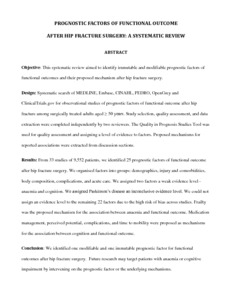Sheehan, KJ; Williamson, L; Alexander, J; Filliter, C; Sobolev, B; Guy, P; Bearne, LM; Sackley, C
(2018)
Prognostic factors of functional outcome after hip fracture surgery: a systematic review.
Age Ageing, 47 (5).
pp. 661-670.
ISSN 1468-2834
https://doi.org/10.1093/ageing/afy057
SGUL Authors: Bearne, Lindsay Mary
![[img]](https://openaccess.sgul.ac.uk/114806/6.hassmallThumbnailVersion/Prognostic_factors_of_functional_outcome_after_hip_fracture_surgery.pdf)  Preview |
|
PDF
Accepted Version
Available under License ["licenses_description_publisher" not defined].
Download (738kB)
| Preview
|
Abstract
Objective: this systematic review aimed to identify immutable and modifiable prognostic factors of functional outcomes and their proposed mechanism after hip fracture surgery. Design: systematic search of MEDLINE, Embase, CINAHL, PEDRO, OpenGrey and ClinicalTrials.gov for observational studies of prognostic factors of functional outcome after hip fracture among surgically treated adults with mean age of 65 years and older. Study selection, quality assessment, and data extraction were completed independently by two reviewers. The Quality in Prognosis Studies Tool was used for quality assessment and assigning a level of evidence to factors. Proposed mechanisms for reported associations were extracted from discussion sections. Results: from 33 studies of 9,552 patients, we identified 25 prognostic factors of functional outcome after hip fracture surgery. We organised factors into groups: demographics, injury and comorbidities, body composition, complications, and acute care. We assigned two factors a weak evidence level-anaemia and cognition. We assigned Parkinson's disease an inconclusive evidence level. We could not assign an evidence level to the remaining 22 factors due to the high risk of bias across studies. Frailty was the proposed mechanism for the association between anaemia and functional outcome. Medication management, perceived potential, complications and time to mobility were proposed as mechanisms for the association between cognition and functional outcome. Conclusion: we identified one modifiable and one immutable prognostic factor for functional outcomes after hip fracture surgery. Future research may target patients with anaemia or cognitive impairment by intervening on the prognostic factor or the underlying mechanisms.
| Item Type: |
Article
|
| Additional Information: |
This is a pre-copyedited, author-produced version of an article accepted for publication in Age and Ageing following peer review. The version of record K J Sheehan, L Williamson, J Alexander, C Filliter, B Sobolev, P Guy, L M Bearne, C Sackley, Prognostic factors of functional outcome after hip fracture surgery: a systematic review, Age and Ageing, Volume 47, Issue 5, September 2018, Pages 661–670 is available online at: https://doi.org/10.1093/ageing/afy057 |
| Keywords: |
Aged, Aged, 80 and over, Anemia, Biomechanical Phenomena, Cognitive Dysfunction, Comorbidity, Female, Fracture Fixation, Health Status, Hip Fractures, Hip Joint, Humans, Male, Recovery of Function, Risk Factors, Time Factors, Treatment Outcome, Hip Joint, Humans, Anemia, Hip Fractures, Treatment Outcome, Fracture Fixation, Risk Factors, Comorbidity, Health Status, Recovery of Function, Time Factors, Aged, Aged, 80 and over, Female, Male, Biomechanical Phenomena, Cognitive Dysfunction, hip fracture, functional recovery, prognosis, systematic review, older people, 1103 Clinical Sciences, 1117 Public Health and Health Services, 1701 Psychology, Geriatrics |
| SGUL Research Institute / Research Centre: |
Academic Structure > Population Health Research Institute (INPH) |
| Journal or Publication Title: |
Age Ageing |
| ISSN: |
1468-2834 |
| Language: |
eng |
| Dates: |
| Date | Event |
|---|
| 1 September 2018 | Published | | 12 April 2018 | Published Online |
|
| Publisher License: |
Publisher's own licence |
| PubMed ID: |
29668839 |
| Web of Science ID: |
WOS:000443540200008 |
 |
Go to PubMed abstract |
| URI: |
https://openaccess.sgul.ac.uk/id/eprint/114806 |
| Publisher's version: |
https://doi.org/10.1093/ageing/afy057 |
Statistics
Item downloaded times since 27 Sep 2022.
Actions (login required)
 |
Edit Item |



